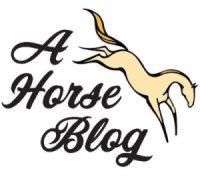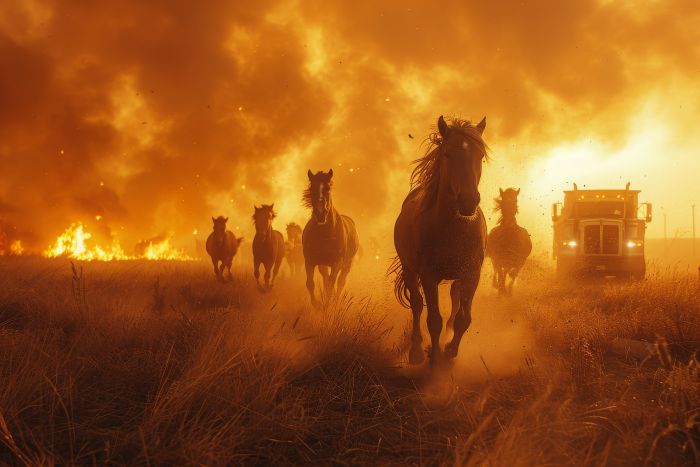Last Updated on February 11, 2025 by Teri Rehkopf
Wildfires in California are relentless. This is a series of stories about these courageous horses affected by wildfires and how they survived. The state’s breathtaking landscapes are often marred by these natural disasters, which affect people, wildlife, and domestic animals. Among those animals, horses stand out for their courage and resilience when faced with the fiery infernos that threaten their lives.
How Can Horses Help When We Have a Wildfire?
One of my biggest fears is wildfire. I grew up living in the country where our 30 acres backed up to a wooded area. About a half-mile from our fenceline was an old building where people would build a still. It caught fire a few times, so we had to battle the ensuing wildfire. I would get on my horse bareback and ride the fire lines that the fire department cut to check the fire status. I loved this and wanted to work for the US Forest Service as a firefighter.
Nowhere to Run
Picture vast open fields suddenly engulfed in flames. The familiar calm is replaced with chaos as horses, creatures of beauty and strength, confront the threat head-on. Imagine the fear, their instinctive need to flee, and sometimes having no place to run to. These magnificent animals face a harrowing reality, often relying on quick thinking and instinctual behavior to survive.
What makes these stories so powerful is not just the horses’ survival through the heat and smoke but also their ability to inspire. With little warning, horses adapt to the fire’s wrath, embodying resilience and hope. These animals show us that survival is possible, even in the harshest conditions, and they’re a testament to the wonders of natural instincts.
Read this: Horses in Disasters Series – Real-Life Survival Stories
Documenting these tales of survival also reveals lessons that extend beyond animals to humans. The balance between nature’s fury and these horses’ steadfastness reminds us of life’s fragility and the strength that comes from instinct and courage.
Understanding these stories of survival isn’t just about observing the past; it’s about recognizing the need for preparedness, advocating for more robust support systems, and appreciating the intricate connection between humans, animals, and our shared environment.
The Story of Ember: A Symbol of Resilience
In 2020, when wildfires swept across California with unrelenting force, Ember, a wild Mustang, found herself in a perilous situation. Flames surrounded the remote ranch where she grazed, and as panic set in for many, Ember was left to rely solely on her instincts for survival.
Read this: Preventing Wildfire with the Wild Horse Fire Brigade
Ember’s remarkable tale is one of both intuition and raw determination. As the heat intensified, she dug into the earth, seeking refuge from the approaching flames. This simple yet profound act gave her a vital layer of protection against the hellacious heat.
Smoke filled the air, a chilling reminder of the danger closing in. Yet, Ember demonstrated innate wisdom, keeping low to avoid the suffocating smoke. This strategic move ensured her survival when others might have succumbed.
Finding water was crucial to her survival. Ember stumbled upon a stream and used it to stay cool and hydrated amidst the chaos. This water source became her sanctuary, a cooling oasis in the fiery tempest.
While Ember’s story doesn’t end without injury—suffering burns and smoke damage—Ember was eventually discovered by firefighters and taken to a sanctuary where she could heal. Her recovery speaks to her resilience, the power of nature’s instincts, and the essential role of human intervention in preserving these beautiful creatures.
Rescue Heroes: The Bravery of California’s “Fire Cowboys”
In the throes of California’s wildfires, a unique group of individuals earned the nickname “Fire Cowboys.” These aren’t your average rescue workers. They’re volunteers—often equestrians themselves— driven by compassion and bravery to save terrified horses.
Read this: Record Precipitation Sets Stage for Record Grass and Brush Wildfire Fuel Growth
These volunteers sprang into action when firestorms threatened ranches and pastures, turning panic into precision. Time became their greatest enemy, yet they managed to load horse trailers with incredible speed, often under blinding smoke and blazing heat.
One notable rescue saw over 50 horses evacuated from a flaming stable in mere hours. This operation wasn’t just about know-how; it was about teamwork and the unyielding spirit of humanity joining forces to save lives beyond just those of people.
Despite their efforts, not every mission ended like these heroes hoped. At times, when evacuation was impossible, horses were set free, their survival left to the mercy of their instincts. It’s a heartrending decision, underscoring the harsh realities these rescuers face.
Yet, their sacrifice and unwavering commitment remain an inspiration. The story of the Fire Cowboys is a testament to the profound impact that individuals can have, reminding us all of the duty to protect and aid those who cannot ask for help themselves.
Survival Instincts of Horses: Lessons in Adaptability
When wildfires threaten their safety, horses rely on remarkable survival instincts. In these dire moments, instinct kicks in, paving the way for astounding tales of adaptability.
The story of a horse surviving by submerging itself in a home’s backyard pool is a striking example. With the fire’s heat bearing down and no escape, the animal instinctively sought refuge in the water. This quick thinking and adaptation to a human-made environment show the lengths horses will go to for survival.
Read this: Prescribed Burns Are Not the Silver Bullet Suggested for Wildfires
These instincts are not just random acts of luck. Horses have evolved over thousands of years to sense danger and respond quickly, a legacy from their wild ancestors who traversed vast and varied landscapes. When faced with imminent risks, their natural behaviors, like fleeing or finding shelter, kick in.
Experts also note that horses tend to stick together, benefitting from the herd’s collective guidance. This social instinct enhances their chances of survival and facilitates more effective rescues, as horses respond better when with familiar companions.
Understanding and respecting these instincts is crucial for those involved in rescues. By aligning strategies with the horses’ natural behaviors, both rescuers and horse owners can improve outcomes, ensuring these majestic creatures have the best chance of surviving such catastrophic events.
Preparedness and Community Support: Key to Saving Lives
Preparation isn’t just smart; it’s essential in the face of California’s fierce wildfires. For horse owners, having a solid evacuation plan can mean the difference between life and death for their animals. It’s about planning for every possible scenario—knowing exits, having transport ready, and understanding the safest routes to take during an evacuation.
Read this: S.M.A.R.T Plans for Survival Preppers, Part 2
But it’s not just about being prepared. Community support plays a massive role in the successful evacuation of horses. Often, it’s the combined efforts of neighbors, local equestrian groups, and fire departments that make the difference. When a crisis hits, these networks spring into action, offering trailers, shelter, and a helping hand to ensure as many animals as possible are led to safety.
It’s remarkable to see how communities band together during these times. Whether it’s offering hay and feed to displaced horses or creating temporary shelters on their properties, people come through to help protect these beautiful creatures. It fosters a sense of unity and shared responsibility, showing that together, we’re stronger.
Still, there are heartbreaking cases where evacuation can’t be achieved. In those moments, having a plan for releasing horses safely, with the best chance of finding a haven, is crucial. This harsh reality underscores the importance of planning comprehensively and having contingencies in place.
By learning from each fire season and supporting each other, communities can continually improve their response strategies. It’s a collective effort where preparedness and support go hand in hand, ensuring that the maximum number of horses find safety when the fire sirens sound.
Lessons Learned and the Path Forward
The stories of horses surviving California’s wildfires are more than just tales of endurance; they’re lessons on preparedness, community collaboration, and respect for natural instincts. As we piece together each narrative, a clearer path forward emerges for equestrian communities and animal lovers alike.
These experiences teach us that thorough preparation is indispensable. Equipping horse owners with emergency protocols and evacuation strategies can greatly reduce risks. Simple measures like familiarizing horses with trailer loading in calm times or pre-arranging temporary stables can be game-changers when seconds count.
Community involvement also proves crucial. The bond shared between horse owners, rescuers, and local volunteers underscores the power of collective action. When communities prepare jointly, everyone benefits. These efforts create a safety net that, although not infallible, provides a critical layer of protection for vulnerable animals.
Moreover, there is a call to enhance policies that support animal safety during natural disasters. Better funding for emergency equipment and training for volunteers is essential. By advocating for these changes, we can better equip those on the front lines, ensuring more lives are safeguarded when disaster strikes.
Ultimately, fostering an environment of constant learning and adaptation is vital. Each wildfire season imparts valuable lessons, which, if embraced, can inform strategies and decisions for future incidents. It’s about building on what works, discarding what doesn’t, and never becoming complacent.
As we move forward, let’s take these lessons to heart. By championing preparedness, supporting community efforts, and lobbying for better resources, we can turn these tales of survival into catalysts for change, creating a safer world for California’s courageous horses and those who strive to protect them.
How about you? Have you used your horse(s) in a survival scenario? Or helped get horses to escape a survival scenario? What were you trying to survive? Let me know how your answer in the comments section below! I love reading your questions and comments and I always reply back.

